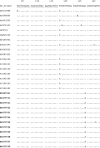Multiplex nested RT-PCR for the detection of porcine enteric viruses
- PMID: 20170679
- PMCID: PMC7112813
- DOI: 10.1016/j.jviromet.2010.02.010
Multiplex nested RT-PCR for the detection of porcine enteric viruses
Abstract
Porcine epidemic diarrhea virus (PEDV), transmissible gastroenteritis virus (TGEV), and porcine group A rotavirus (PRV-A) are major viruses causing enteric diseases of piglets. A multiplex nested reverse transcription polymerase chain reaction (multiplex nested RT-PCR) was developed for the detection of these viruses in field samples from piglets with diarrhea. A mixture of (1) three external pairs of primers, yielding in the amplification step two different amplicons with sizes of 950 bp and 317 bp and (2) three pairs of internal primers in a second round of PCR (nested PCR), yielding two different amplicons with sizes of 792 bp and 208 bp for TGEV and porcine PRV-A, respectively. The genome of PEDV was not detected after the amplification step but it was detected in the second round of PCR, yielding amplicon with size of 291 bp. Multiplex nested RT-PCR can detect TGEV, PRV-A, and PEDV up to concentration 10(2) TCID(50)/mL, 10(1) TCID(50)/mL, and 27.2 microg/microl of RNA, respectively. A total of 175 field samples were collected from swine with diarrhea from January 2005 until July 2007. The samples were tested for the presence of three viruses by a multiplex nested RT-PCR. Dual infections with PEDV and PRV-A were identified in seven specimens (4%) (n = 6). Twenty-one (25%) infections were caused by PEDV and thirty-four infections (41%) were caused by PRV-A. The genome of TGEV was not detected in any of these field samples, however TGEV was detected in piglets infected experimentally. The multiplex nested RT-PCR is rapid, sensitive, and a cost-effective detection method for the detection of porcine enteric viruses.
Copyright 2010 Elsevier B.V. All rights reserved.
Figures








Similar articles
-
Multiplex reverse transcription-PCR for rapid differential detection of porcine epidemic diarrhea virus, transmissible gastroenteritis virus, and porcine group A rotavirus.J Vet Diagn Invest. 2006 May;18(3):278-81. doi: 10.1177/104063870601800309. J Vet Diagn Invest. 2006. PMID: 16789718
-
Development of a multiplex RT-PCR for the detection of major diarrhoeal viruses in pig herds in China.Transbound Emerg Dis. 2020 Mar;67(2):678-685. doi: 10.1111/tbed.13385. Epub 2019 Oct 28. Transbound Emerg Dis. 2020. PMID: 31597013 Free PMC article.
-
Establishment and application of a quadruplex real-time RT-qPCR assay for differentiation of TGEV, PEDV, PDCoV, and PoRVA.Microb Pathog. 2024 Jun;191:106646. doi: 10.1016/j.micpath.2024.106646. Epub 2024 Apr 16. Microb Pathog. 2024. PMID: 38631414
-
An overview of immunological and genetic methods for detecting swine coronaviruses, transmissible gastroenteritis virus, and porcine respiratory coronavirus in tissues.Adv Exp Med Biol. 1997;412:37-46. doi: 10.1007/978-1-4899-1828-4_4. Adv Exp Med Biol. 1997. PMID: 9191988 Review.
-
Porcine enteric coronaviruses: an updated overview of the pathogenesis, prevalence, and diagnosis.Vet Res Commun. 2021 Sep;45(2-3):75-86. doi: 10.1007/s11259-021-09808-0. Epub 2021 Jul 12. Vet Res Commun. 2021. PMID: 34251560 Free PMC article. Review.
Cited by
-
A novel biotinylated nanobody-based blocking ELISA for the rapid and sensitive clinical detection of porcine epidemic diarrhea virus.J Nanobiotechnology. 2019 Sep 16;17(1):96. doi: 10.1186/s12951-019-0531-x. J Nanobiotechnology. 2019. PMID: 31526383 Free PMC article.
-
A portable, 3D printed, microfluidic device for multiplexed, real time, molecular detection of the porcine epidemic diarrhea virus, transmissible gastroenteritis virus, and porcine deltacoronavirus at the point of need.Lab Chip. 2021 Mar 21;21(6):1118-1130. doi: 10.1039/d0lc01229g. Epub 2021 Feb 2. Lab Chip. 2021. PMID: 33527920 Free PMC article.
-
Current State of Molecular and Serological Methods for Detection of Porcine Epidemic Diarrhea Virus.Pathogens. 2022 Sep 21;11(10):1074. doi: 10.3390/pathogens11101074. Pathogens. 2022. PMID: 36297131 Free PMC article. Review.
-
Dual priming oligonucleotide (DPO)-based real-time RT-PCR assay for accurate differentiation of four major viruses causing porcine viral diarrhea.Mol Cell Probes. 2019 Oct;47:101435. doi: 10.1016/j.mcp.2019.101435. Epub 2019 Aug 12. Mol Cell Probes. 2019. PMID: 31415867 Free PMC article.
-
Establishment and application of a TaqMan-based multiplex real-time PCR for simultaneous detection of three porcine diarrhea viruses.Front Microbiol. 2024 Apr 16;15:1380849. doi: 10.3389/fmicb.2024.1380849. eCollection 2024. Front Microbiol. 2024. PMID: 38690365 Free PMC article.
References
-
- Cavanagh D. Nidovirales: a new order comprising Coronaviridae and Arteriviridae. Arch. Virol. 1997;142:629–633. - PubMed
-
- Dean A.G., Arner T.G., Sunki G.G., Friedman R., Lantinga M., Sangam S., Zubieta J.C., Sullivan K.M., Brendel K.A., Gao Z., Fontaine N., Shu M., Fuller G., Smith D.C., Nitschke D.A., Fagan R.F. Centers for Disease Control and Prevention; Atlanta, GA, USA: 2007. Epi Info™, A Database and Statistics Program for Public Health Professionals.
-
- Elschner M., Prudlo J., Hotzel H., Otto P., Sachse K. Nested reverse transcriptase polymerase chain reaction for the detection of group A rotavirus. J. Vet. Med. 2002;49:77–81. - PubMed
-
- Gribanov O.G., Shcherbakov A.V., Perevozchikova N.A., Drygin V.V., Gusev A.A. A simple method for RNA isolation and purification. Bioorg. Khim. 1997;23:763–765. (Abstract) - PubMed
-
- Hall T.A. BioEdit: a user friendly biological sequence alignment editor and analysis program for windows 95/98/NT. Nucl. Acids. Symp. Ser. 1999;41:95–98.
MeSH terms
Substances
Associated data
- Actions
- Actions
- Actions
- Actions
- Actions
- Actions
- Actions
- Actions
- Actions
- Actions
- Actions
- Actions
- Actions
- Actions
- Actions
- Actions
- Actions
- Actions
- Actions
- Actions
- Actions
- Actions
- Actions
- Actions
- Actions
- Actions
- Actions
LinkOut - more resources
Full Text Sources
Other Literature Sources
Medical

